|
 REGRET
my decision to have permanent eyeliner and lip-liner in early November
2003. I wish I had given it more thought and done the research before
I assumed that permanent make-up tattoos were safe. After all, people
have been getting tattoos for thousands of years, and my only concern REGRET
my decision to have permanent eyeliner and lip-liner in early November
2003. I wish I had given it more thought and done the research before
I assumed that permanent make-up tattoos were safe. After all, people
have been getting tattoos for thousands of years, and my only concern
| The pigment manufacturer,
Premier Pigments, was well aware of the allergic reactions associated
with their product and did not disclose it. I also learned that
industrial paint had been used as one of the ingredients
|
then was finding an experienced tattoo artist at a reputable salon.
The procedure, micropigmentation, is better known
as permanent make-up. The name can be misleading because the colour
eventually fades and a touch-up is normally required within three
years. Besides its association with make-up, micropigmentation has
been instrumental in scar camouflage and aiding in medical reconstruction.
I was initially happy with the results. I did not
have the need to wear eyeliner and my lips were well defined by the
lip-liner tattoo, which was a little darker than my natural lip colour.
Nobody noticed anything different about me at work, but everybody
told me that I looked great. Everyone thought that I had used eyeliner
for a change because it was rare for me to wear make-up other than
lipstick. Itís not that I dislike wearing make-up; I just donít have
the time to go through the daily ritual of make-up application.
Iíve never liked tattoos and I never understood
why people wanted tattoos on their bodies even despite the recent
fashion fad. Somehow this was different because it looked like make-up.
Yet, what if the tattoo artist made mistakes and the results were
uneven? Or worse, what if the colour didnít turn out the way I anticipated?
What if new needles were not used and the salon products were not
sterile? What about the risks of infections including hepatitis B
and C as well as HIV?
I never thought I would take this risk because the
disadvantages always seemed to outweigh the advantages of permanent
make-up. Iíve always been scared of needlesóanything that could possibly
cause me any pain!
Then, my mother decided to have permanent make-up
a year ago and the results were incredible. The permanent make-up
technician, my motherís friend, has over eight yearsí experience in
applying permanent make-up and works at a doctorís office, aside from
offering the service at her Carmel, Calif. beauty salon. I especially
liked my motherís lip liner since it looked so natural with a hint
of colour. Therefore, the lip liner was very subtle and didnít stand
out if my Mom decided not to use lipstick. So, I changed my mind about
permanent make-up. I suddenly met many people who had great results
with permanent make-up. My mother encouraged me to do it and I surprised
myself the most by my decision to have permanent make-up.
The procedure wasnít painful because numbing creams
were applied to areas that were going to be worked on. Afterwards,
I was instructed to ice my eyes and lips and use antibiotic creams
for a few days, without wearing make-up for 10 days. The swelling
didnít really go down and my lips became more irritated until it was
obvious that something was wrong. My allergic reaction symptoms consisted
of burning, itching, swelling, bumps or so-called Ďgranulomasí, dryness,
peeling, bleeding, and the constant formation of yellowish fluids
around my eyes and lips that were impossible to completely remove.
My lips were sensitive to the touch and my eyes hurt when I blinked.
I still canít open my mouth wide enough to floss my teeth and I have
to use baby utensils in order to eat. In addition, I still have swollen
lymph nodes because I have big lumps under my chin and the sides of
my face. At one point, my eyes and lips were infected and I was on
antibiotics.
I was told that a small percentage of people react
to permanent make-up tattoos. I was also told that I didnít have to
worry about allergic reactions since I havenít had a history of allergies
or any cold sores. Yet, my tattoo artist didnít have any experience
with these allergic reactions and wouldnít have been able to explain
the severity of the potential allergic reaction to me.
On the other hand, the pigment manufacturer, Premier
Pigments, was well aware of the allergic reactions associated with
their product. Later, I found a notice on the internet from this manufacturer
claiming that they had reported the allergic reactions to the Food
and Drug Administration (FDA) of the
United States. The FDA confirmed that
this company had never reported any issues or adverse reactions.
These tattoo pigment companies are not required
to provide a list of all their ingredients to doctors who rely on
this information in order to attempt to treat patients with the allergic
reaction. I also learned that industrial paint had been used as one
of the ingredients based on general research on the topic.
Prior to my research, I didnít realize how common
the allergic reactions were and what the consequences were. I simply
thought that I could visit my local dermatologist and get a quick
fix for my allergic reaction. I now know that my reaction is not an
isolated incident and many other women are allergic to the same pigment
brand. Actually, there have been recent cases where women only got
the allergic reaction when they returned for their second or third
touch-up treatment.
It was a challenge for me to find a doctor who could
treat my condition. I was doctor-hopping for at least four months
and every doctor said that they had not seen anything like it. They
all prescribed steroid creams that only eased the burning, itching
sensation while my appearance continued to appear abnormal. Most doctors
recommended getting the allergic reaction in a controlled state with
steroid injections before I had the tattoo pigments removed via laser.
Iíve always been healthy and health-conscious and I didnít permit
any steroids to be injected in my body. Later, I learned that steroid
injections and oral steroids were temporary suppressants, not a solution.
There are many doctors who are trained to remove
tattoos by laser, but none of them wanted to treat a condition that
they were unfamiliar with. Finally, I reported my allergic reaction
to the FDA and they referred me to Dr
Linda Dixon in Hawaii. Dr Dixon, Anæsthesiologist, is the president
of the American Academy of Micropigmentation (www.micropigmentation.org),
which is a non-profit organization dedicated to promoting excellence
in micropigmentation through a voluntary examination for its members.
Dr Dixon referred me to Dr Mitchel Goldman of La Jolla Spa MD
(www.spa-md.com), in La Jolla,
Calif. Dr Goldman, Board Certified Dermatologist, Cosmetic Surgeon,
the Medical Director of La Jolla Spa MD,
author of numerous books, has had experience treating allergic reactions
due to permanent make-up and specializes in many cosmetic procedures
of dermatology, phlebology, laser surgery and liposuction.
Iím actually still travelling once a month from
my home in northern California to southern California for routine
laser treatments and doctor appointments. I may need up to 30 laser
sessions. With each visit, I am greeted by new doctors who want to
observe my condition. I wish that my costs were many painstaking months
of recovery and expensive laser treatments. It is very likely that
I will never look the way I did before I had permanent make-up. I
will have scars and discoloration as a result of the allergic reaction
and laser therapy. A miracle will only give me my normal appearance
back. ē
Nancy Erfan is a realtor based in California and
a Lucire reader.
Note: The FDA issued a
warning about certain Premier Pigments’ ink shades as this
article went to press, carried in Associated Press and Reuter reports.
The manufacturer, the American Institute of Intradermal Cosmetics,
claims that it had asked the FDA to investigate the allergic reactions
in 2003 and had recalled five shades. However, the FDA received
complaints concerning shades not subject to Premier’s recall.
US consumer enquiries should be directed to 1 888 INFO-FDA.
|
 
ABOVE: Nancy Erfan’s
eye and lip before the permanent make-up process. BELOW:
Nancy’s excruciating reaction to the process and the eventual,
but steady, reduction in swelling thanks to laser treatment from
Dr Mitchel Goldman in La Jolla, Calif.
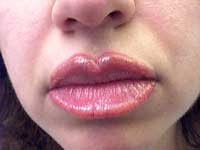
April 9, 2004
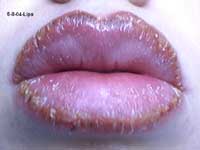
May 8, 2004

May 12, 2004
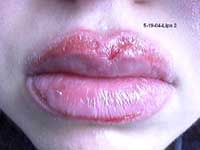
May 19, 2004, five days after laser
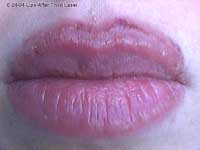
June 23, 2004, after third laser
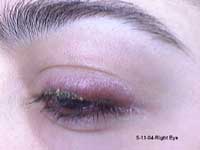
May 13, 2004
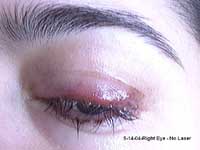
May 14, 2004, before laser
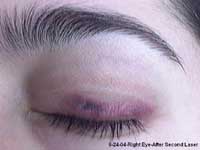
June 24, 2004, after second laser
|

